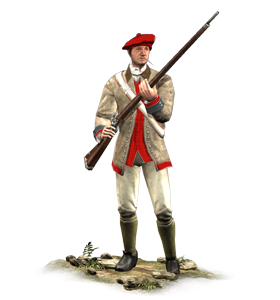Difference between revisions of "Militia (ETW Unit)"
(→Overview) |
|||
| Line 10: | Line 10: | ||
Militia, and their equivalents, are useful in the early game as cheaper alternatives to line infantry (despite their inferior statistics). They become less effective, however, when more and more nations field regular line infantry in their armies. Militia also do not benefit from the Fire by Rank technology, effectively meaning they have only a third of the firepower of line infantry when this technology is researched. However, militia remain useful in the late game for putting down rebellions and keeping the peace (they recieve a bonuses in repression). | Militia, and their equivalents, are useful in the early game as cheaper alternatives to line infantry (despite their inferior statistics). They become less effective, however, when more and more nations field regular line infantry in their armies. Militia also do not benefit from the Fire by Rank technology, effectively meaning they have only a third of the firepower of line infantry when this technology is researched. However, militia remain useful in the late game for putting down rebellions and keeping the peace (they recieve a bonuses in repression). | ||
| − | + | ||
| + | Like some other units such as artillery and light infantry, militia gain the option to pre-deploy some defensive measures on a battlefield should they remain in the place on the campaign map for more than two turns: defensive barriers behind which militia can shoot and crouch. This grants militia much more resistance against enemy musket fire, and somewhat slows and weakens charges. | ||
| + | |||
==Factions== | ==Factions== | ||
*[[Image:Austria_flag.jpg|25px]] [[Austria (ETW Faction)|Austria]] | *[[Image:Austria_flag.jpg|25px]] [[Austria (ETW Faction)|Austria]] | ||
Revision as of 09:13, 31 July 2011
Game Description
Militia or provincial troops are commonly held to be inferior to regular soldiers and, although they are trained to use the same tactics as marching regiments of the line, there is some truth in this assertion. Militia are expected to act as reassuring presence, and sometimes as a police force in suppressing local disturbances.
Historically, it was not unusual for militia to be locals recruited as part-time soldiers while retaining their day jobs and trades. In Britain, for example, service in the militia was seen as a good idea: you not only looked very patriotic for volunteering, but you could not be sent overseas! For ambitious would-be officers, there was a hidden financial benefit to joining the militia. A commander who could persuade his men to transfer to the army with him would not have to pay the cost of his regular commission.
Overview
Militia, and their equivalents, are useful in the early game as cheaper alternatives to line infantry (despite their inferior statistics). They become less effective, however, when more and more nations field regular line infantry in their armies. Militia also do not benefit from the Fire by Rank technology, effectively meaning they have only a third of the firepower of line infantry when this technology is researched. However, militia remain useful in the late game for putting down rebellions and keeping the peace (they recieve a bonuses in repression).
Like some other units such as artillery and light infantry, militia gain the option to pre-deploy some defensive measures on a battlefield should they remain in the place on the campaign map for more than two turns: defensive barriers behind which militia can shoot and crouch. This grants militia much more resistance against enemy musket fire, and somewhat slows and weakens charges.
Factions
 Austria
Austria France
France Great Britain
Great Britain Poland-Lithuania
Poland-Lithuania Prussia
Prussia Spain
Spain Sweden
Sweden United Provinces
United Provinces United States (as Militia Infantry)
United States (as Militia Infantry)
